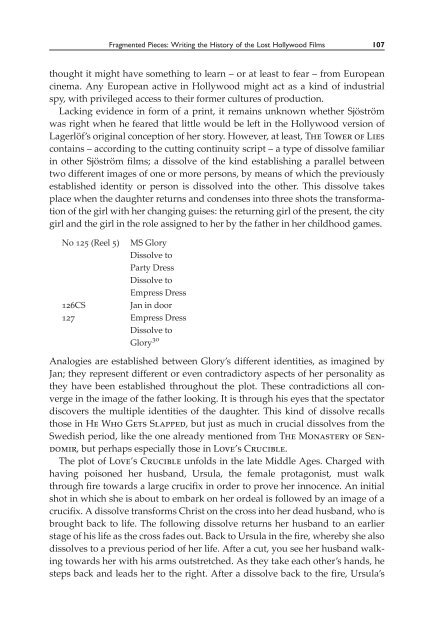FILM FILM - University of Macau Library
FILM FILM - University of Macau Library
FILM FILM - University of Macau Library
Create successful ePaper yourself
Turn your PDF publications into a flip-book with our unique Google optimized e-Paper software.
Fragmented Pieces: Writing the History <strong>of</strong> the Lost Hollywood Films 107<br />
thought it might have something to learn – or at least to fear – from European<br />
cinema. Any European active in Hollywood might act as a kind <strong>of</strong> industrial<br />
spy, with privileged access to their former cultures <strong>of</strong> production.<br />
Lacking evidence in form <strong>of</strong> a print, it remains unknown whether Sjöström<br />
was right when he feared that little would be left in the Hollywood version <strong>of</strong><br />
Lagerlöf’s original conception <strong>of</strong> her story. However, at least, The Tower <strong>of</strong> Lies<br />
contains – according to the cutting continuity script – a type <strong>of</strong> dissolve familiar<br />
in other Sjöström films; a dissolve <strong>of</strong> the kind establishing a parallel between<br />
two different images <strong>of</strong> one or more persons, by means <strong>of</strong> which the previously<br />
established identity or person is dissolved into the other. This dissolve takes<br />
place when the daughter returns and condenses into three shots the transformation<br />
<strong>of</strong> the girl with her changing guises: the returning girl <strong>of</strong> the present, the city<br />
girl and the girl in the role assigned to her by the father in her childhood games.<br />
No 125 (Reel 5) MS Glory<br />
Dissolve to<br />
Party Dress<br />
Dissolve to<br />
Empress Dress<br />
126CS Jan in door<br />
127 Empress Dress<br />
Dissolve to<br />
Glory 30<br />
Analogies are established between Glory’s different identities, as imagined by<br />
Jan; they represent different or even contradictory aspects <strong>of</strong> her personality as<br />
they have been established throughout the plot. These contradictions all converge<br />
in the image <strong>of</strong> the father looking. It is through his eyes that the spectator<br />
discovers the multiple identities <strong>of</strong> the daughter. This kind <strong>of</strong> dissolve recalls<br />
those in He Who Gets Slapped, but just as much in crucial dissolves from the<br />
Swedish period, like the one already mentioned from The Monastery <strong>of</strong> Sendomir,<br />
but perhaps especially those in Love’s Crucible.<br />
The plot <strong>of</strong> Love’s Crucible unfolds in the late Middle Ages. Charged with<br />
having poisoned her husband, Ursula, the female protagonist, must walk<br />
through fire towards a large crucifix in order to prove her innocence. An initial<br />
shot in which she is about to embark on her ordeal is followed by an image <strong>of</strong> a<br />
crucifix. A dissolve transforms Christ on the cross into her dead husband, who is<br />
brought back to life. The following dissolve returns her husband to an earlier<br />
stage <strong>of</strong> his life as the cross fades out. Back to Ursula in the fire, whereby she also<br />
dissolves to a previous period <strong>of</strong> her life. After a cut, you see her husband walking<br />
towards her with his arms outstretched. As they take each other’s hands, he<br />
steps back and leads her to the right. After a dissolve back to the fire, Ursula’s

















